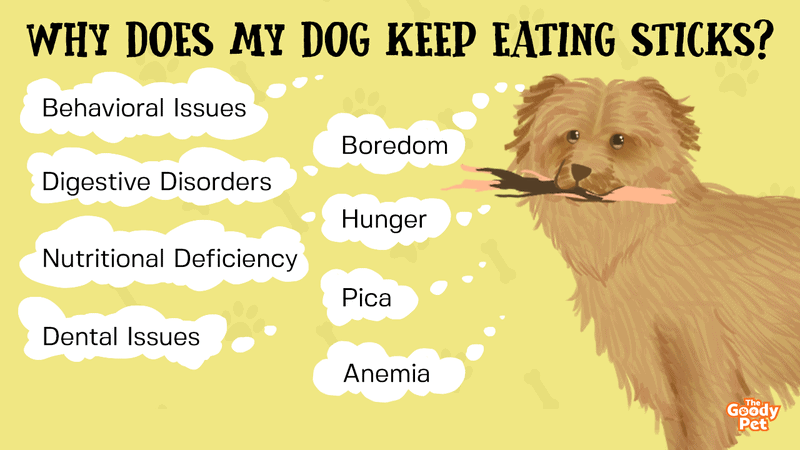So, you’ve noticed your pooch picks up a stick and begins eating it while you were both out in the yard. Isn’t it adorable? You may have been thinking that it is normal for dogs to do this kind of action, but now you’re wondering and asking yourself, “should I be worried?”
Dogs are extraordinary animals, especially when it comes to their capacity to endanger themselves with apparently simple objects. While it’s unlikely that your pooch may injure itself with something as harmless as a branch or a pebble, it is possible.
Dogs eat sticks primarily because they are suffering from pica, an eating disorder that dogs do to seek comfort. In addition, sticks, when fractured, can cause splinters that may harm dogs in unexpected ways; hence, as a responsible dog owner, you should be fully aware of the reasons behind your dog’s erratic behavior towards sticks.
Dogs enjoy looking for things to chew on. Chewing is one of their natural habits in order to maintain their teeth and gums healthy. Sticks, on the other hand, are a unique case. The following information will disclose the dangers of dogs chewing on sticks, as well as possible prevention methods.
Is It Safe For My Dogs To Eat Sticks?
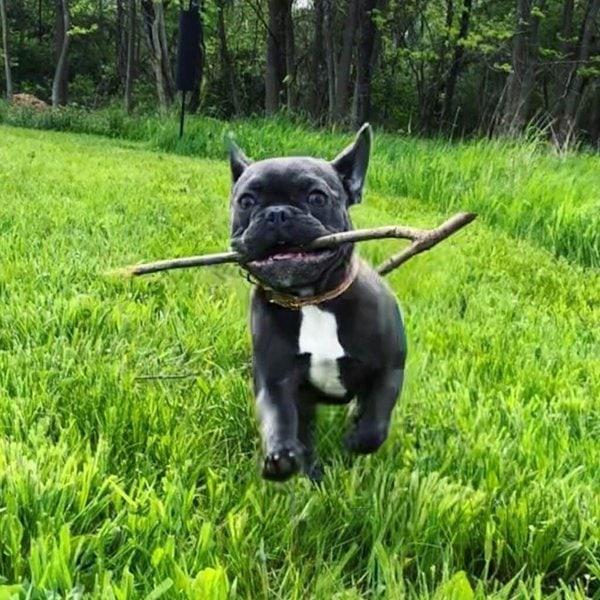
Sticks aren’t safe for your canine pet to consume, even if they are only chewed and not ingested. This is because splinters can get into their mouths, teeth, and gums. This could result in infections.
Also, swallowing sticks is bad for your pooch since it can cause blockages in their intestines, which can be deadly in the worst-case situation.
Chewing sticks is a pleasurable experience for many dogs, and it can even be a stress reliever for some. However, now that you have known that sticks aren’t safe for your dog, should you be worried if you see your dog chewing a stick? You may find this out in the next section.
Do I Need To Worry If My Dogs Eat Sticks?
There’s no need to be worried if your dog chews just one popsicle stick or other non-food objects. However, if it’s a large chunk of wood, not only do you have to be concerned about your pooch developing a medical condition as a result of it, but it can also cause more problems down the line.
Should I Stop My Dogs From Eating Sticks?
Sadly, eating sticks isn’t as safe as you may believe. Eating on sticks can cause serious difficulties for your pet, and it’s up to you to break the behavior. However, we advise you to stop your doggie from eating sticks as it can be a harmful as well as an unwanted habit.
Can My Dog Digest The Sticks?
Because dogs enjoy chewing on everything, there’s a good chance that a small stick won’t go down whole. The stick will have been partially digested, so check your dog’s stools in the next 24 to 48 hours to see if it has reappeared.
If the dog consumes the splinter instead of inhaling it, it may breach the digestive tract wall, triggering a chain of events that eventually leads to life-threatening abdominal inflammation.
If the dog swallows a larger wood stick or multiple splinters, they may induce a gastrointestinal obstruction, necessitating surgical intervention to remove them.
Why Does My Dog Keep On Eating Sticks?
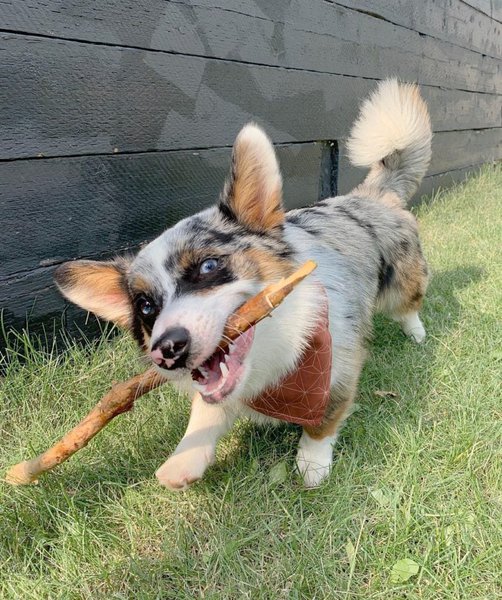
There are various reasons why your dog continues to eat sticks, and the majority of them can indicate a medical issue. The following are the most common reasons:
Behavioral Issues
Your dog may eat sticks as a result of a variety of behavioral problems. The following are a few of the most common:
- Anxiety
- Fear
- Stress
- Seeking attention
If your dog has a behavioral issue, you’ll need to stay patient, give them enough attention, love, and persistence while you strive to retrain your doggie. You may require the assistance of a dog trainer or, more specifically, a canine behaviorist.
Digestive Disorders
Another reason why your doggie keeps on eating sticks has a digestive disorder. IIf your pooch has digestive problems, X-rays will show them. Difficulties absorbing nutrition can be caused by a variety of digestive problems. Here are a few examples:
- Tumors
- Gastritis
- Worms
- Stomach inflation
- Inflammatory Bowel Disease (IBD)
Boredom
When dogs have too much energy, they tend to act out. A bored dog with a lot of energy is a disaster waiting to happen, and your dog may resort to compulsive chewing. So, eating on a stick could be the ideal solution to that problem, regardless of how dangerous it is!
Anemia
Various medical problems, such as intestinal hemorrhage or leukemia, can induce anemia. It’s also possible that your canine pet’s food isn’t supplying them with enough nutrients. Because of the preservatives in substandard commercial food, your canine buddy isn’t eating properly and is adjusting by eating sticks.
If your dog has been eating sticks on a regular basis, a physical evaluation by a veterinarian is required. They will do blood tests to determine whether the dog is anemic or suffers from a mineral deficiency.
Dental Issues
If your pooch has a dental problem, such as cavities or gum disease, they may be eating on sticks to relieve the pain. However, this will almost certainly worsen the situation.
MRI and CT scans may be done by the veterinarian to see if your pooch has dental issues. The vet will check your doggie’s teeth for dental issues and refer him to a veterinary dentist if the condition is more serious.
Pica
Pica is a condition that causes canines to consume things that aren’t food. If your pooch is continually eating and chewing inconvenient stuff, you should consult your veterinarian about a probable condition. Pica in a dog can be caused by a variety of factors. This includes the following:
- Nausea
- Anxiety
- Stress
Nutritional Deficiency
Artificial additives and preservatives in some low-quality commercial dog diets might make it harder for your pooch to obtain enough nutrients. Your doggie may not acquire all of the nutrients they require if they eat this non-essential food.
This can also happen if your dog eats more snacks than meals or is offered an imbalanced home-cooked diet. Your dog may try to get nutrients from other sources, like sticks, if your dog has a nutritional deficiency.
Aside from anemia, your veterinarian may be able to identify if your dog has any nutritional or mineral deficiencies through blood tests.
Hunger
Has anyone observed that your pup isn’t eating all of the food you placed in the bowl for them? If this is the scenario, or if other animals in your home are eating some of your furry pet’s food, your dog may be starving. When your canine is hungry, a stick will probably taste good enough for them to eat it.
What Happens To My Dog After Eating Sticks?
Whenever canines chew wood, the wood is broken into numerous sharp pieces by their teeth, which can harm their bodies in a variety of ways. Broken teeth can cause discomfort as well as infection. Dental abscesses can result from this.
These small fragments can become stuck in the gums, causing an infection to develop beneath the tissue. If the splinters are left in the mouth, the infection can progress to an abscess. Abscesses are terribly painful and can result in significant swelling in the affected area.
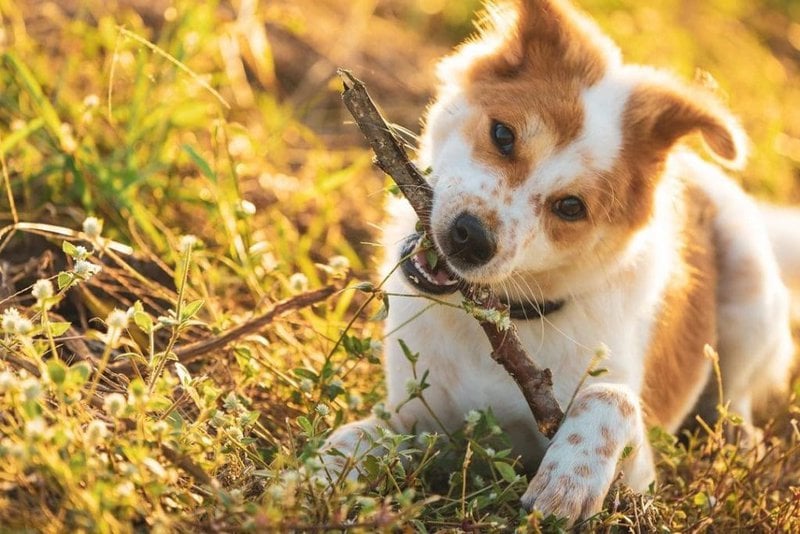
How Do I Know If The Stick Has Been Stuck In My Dog’s Throat?
First, keep track of how many times and how long your canine acts as if something is stuck in its throat. If it had only happened once, your dog might have already taken the item out. Even if you don’t know what’s causing it, you’ll notice indicators that something is wrong.
The following are the most common symptoms of a foreign object trapped in your furry pet’s throat:
- Vomiting
- Trouble breathing
- Excessive drooling
- Loss of appetite
- Gagging sounds
- Restlessness
Can My Dog Get Diarrhea From Eating Sticks?
Yes, it is possible for your pooch to get diarrhea from eating sticks. Diarrhea can be caused by your dog eating non-digestible things such as tree bark or wooden sticks. Wooden sticks should be able to pass through their stool. If your pooch appears to be in severe pain, seek medical attention right once.
How Do I Get My Dog To Stop Eating Sticks?
If your dog is eating sticks when off-leash, simply placing a leash on your doggie can help you be more aware of your dog so that you can stop them from eating objects.
The following are some more options:
Ensure Your Dog’s Diet Has Plenty Of Iron
To avoid anemia, ensure your canine is eating high-iron food and getting frequent health checks from your trusted veterinarian. In most dogs, anemia is identified through routine blood tests. Also, make sure that your dog is parasite-free.
Use A Basket Muzzle
Many pet owners have had satisfaction using a basket muzzle to keep their dogs from eating unwanted objects. It’s essential to spend much time teaching your pooch to wear the muzzle as they will most likely dislike it at first and want to remove it. Your dog will eventually learn that the muzzle implies nice things like snacks and walks.
Make Your Dog Wear An Elizabethan Collar
Another alternative is to use an Elizabethan collar, similar to the ones used on dogs following surgery. Pick something that’s longer than your furry pet’s snout to prevent your dog from reaching the ground to pick up sticks.
Wearing an E-collar is the most difficult of the available methods, but it may be the most comfortable for your dog.
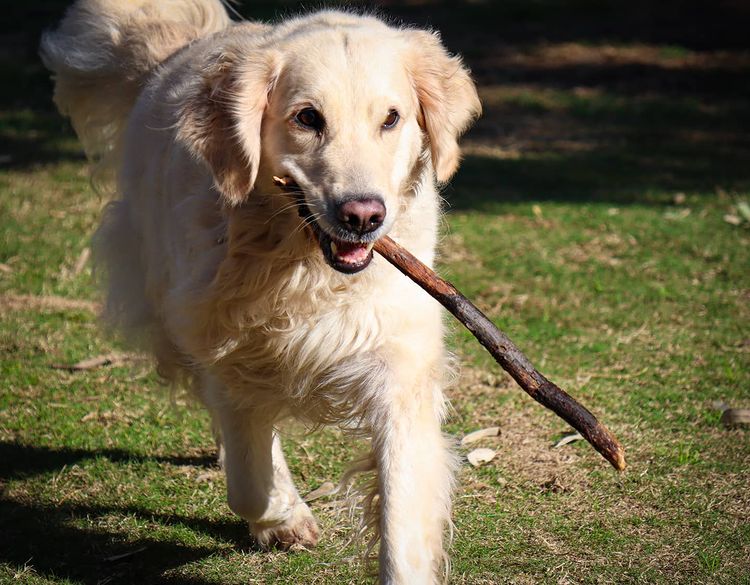
Monitor Your Dog While Outside
If your canine is eating sticks when alone in the yard, the best recommendation is to never leave your dog outside unattended or to build an outside environment free of sticks. If you can’t keep an eye on your dog while being out in the yard, the best solution is to make sure your dog’s needs are addressed.
Teach Your Dog A Command
Training your dog to leave the stick is a good way to get an item out of its mouth. This command can be used to teach your doggie not to chew sticks in the first place.
Begin by holding your dog’s favorite treat in your closed palm. Ensure your dog is aware that the dog treat can be seen or that it can be smelled.

